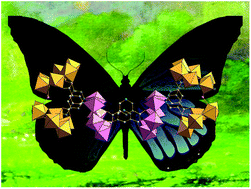Construction of a new binding manner in carboxylic acid-functionalized phosphomolybdates†
Abstract
Carboxylic acid-functionalized polyoxomolybdates have been widely reported. In this study, we tried to establish a new connection pattern between an organic carboxylic acid ligand and inorganic phosphomolybdates by employing N-containing pyridine dicarboxylic acids and two other benzene dicarboxylic acids. Herein, four kinds of organic–inorganic hybrids have been synthesized. Studies reveal that these compounds are dimers, trimer or hexamer, displaying the templating effect of different carboxylic acids. In compound 2, besides the normal C–O–Mo bonds, a new binding manner of C–N–Mo bonds was presented as a linker to connect the organic and inorganic portions, and the polyanion demonstrated the conformation of a hexamer. Moreover, the photochromic properties of these compounds were studied, and the kinetics of the coloration process was analyzed and compared. It seems that based on the aromaticity of their organic ligands, the t1/2 values of the four compounds are much less than those of the compounds functionalized by aliphatic acids.



 Please wait while we load your content...
Please wait while we load your content...